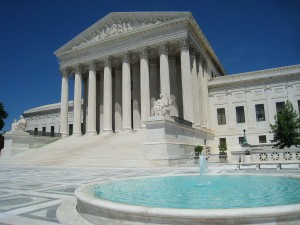Experienced Federal Appeal Attorneys: Skilled Representation for Complex Cases
Experienced Federal Appeal Attorneys: Skilled Representation for Complex Cases
Blog Article
Demystifying the Refine of Federal Appeals: What You Need to Know
Navigating the intricate realm of federal charms can usually look like going across uncharted waters for those not familiar with the procedure. Comprehending the nuances of appellate court territory, the ins and outs of filing a notification of appeal, presenting an engaging short, and making an influential oral debate are important elements that can considerably affect the outcome of a situation. By unraveling the layers of complexity surrounding federal charms, people can get a clearer insight right into the systems that govern this vital phase of the lawful system.
Comprehending Federal Appeals Refine
Looking into the detailed realm of the federal appeals procedure reveals a structured and systematic trip through the judicial system. Federal allures act as an essential device for assessing choices made by reduced courts. Comprehending this procedure is necessary for any individual included in legal procedures at the government level.
The process usually begins with a party disappointed with a reduced court's ruling submitting a notice of charm. This sets off a testimonial by a higher court, where a panel of courts analyzes the lawful debates presented by both celebrations. Briefs detailing the legal reasoning behind each party's position are sent, and oral disagreements may be heard to clarify complex concerns.
The appellate court's decision is based on a detailed evaluation of the reduced court's proceedings and the disagreements provided. When the appellate court reaches a decision, it can attest, turn around, remand, or customize the reduced court's judgment, supplying clearness and finality to the lawful disagreement.
Appellate Court Jurisdiction Described
As we proceed from recognizing the government appeals process to dissecting the intricacies of appellate court jurisdiction, a basic element emerges regarding the authority and limits of these greater courts in the lawful landscape. Appellate court jurisdiction describes the extent of instances that a certain appellate court has the power to examine and choose upon. Unlike high court that listen to instances for the very first time, appellate courts are restricted to examining decisions made by reduced courts. These decisions can include judgments from both state and government courts.
Appellate courts have territory over specific kinds of situations, typically those entailing legal mistakes, procedural problems, or inquiries of legislation as opposed to factual conflicts. The territory of appellate courts is normally detailed in statutes and legislations that control the court system. Recognizing appellate court jurisdiction is essential for events associated with the appeals procedure as it establishes whether an instance is eligible for review and the degree to which the appellate court can interfere in the lower court's choice.
Declaring a Notification of Appeal
The initial action in beginning the federal allures procedure involves submitting a Notification of Appeal with the ideal appellate court. This vital paper formally notifies the court and the various other celebrations included in the situation that the appealing party means to seek a review of the reduced court's decision. Submitting a Notice of Appeal is a stringent procedural requirement that establishes the appellate procedure in activity.
When preparing the Notice of Allure, it is vital to make sure compliance with the specific rules and standards of the relevant appellate court. federal appeal attorneys. The file needs to typically consist of info such as the situation name, the reduced court's name, the date of the judgment being appealed, and a succinct statement indicating the grounds for the charm

Rundown and Dental Debate
In the appellate procedure, presenting created briefs and involving in dental arguments play essential functions in promoting for the appealing celebration's position prior to the appellate court. Briefs are thorough lawful files that describe the celebrations' debates, lawful authorities, and analysis supporting their positions. These created submissions provide the court with a comprehensive understanding of the truths of the instance, the relevant legislation, and why the appealing celebration thinks the lower court's decision must be overturned.
Following the submission and testimonial of the briefs, oral arguments use the parties a possibility to more clarify their positions, address any kind of concerns the appellate judges may have, and highlight key points from their composed briefs. Dental arguments are a chance for the attorneys to convince the courts through verbal advocacy and reactions to inquiries from the bench.
Both the composed briefs and oral arguments are essential components of the appellate process, allowing celebrations to offer their instance completely and compellingly before the appellate court. - federal appeal lawyers
Obtaining the Appellate Court Choice
The appellate court's choice is normally provided in a composed style and details the court's final thoughts on the legal issues provided, the thinking behind their choice, and the judgment rendered. The time frame for getting the appellate court's decision can vary, yet courts make every effort to give timely resolutions. Whether the appellate court verifies, reverses, or remands the reduced court's choice, recognizing the effects of the judgment is important for all parties entailed in the appellate process.
Conclusion
Recognizing the appellate court jurisdiction, filing a notice of allure, preparing briefs, and presenting dental arguments are all essential elements of this process. Eventually, receiving the appellate court decision can give clarity and resolution to legal conflicts.
As we progress from recognizing the federal charms process to studying the ins and outs of appellate court jurisdiction, an essential element comes to light pertaining to the authority and limits of these higher courts in the lawful click over here landscape. Appellate court territory refers to the scope of cases that a certain appellate court has the power to assess and choose upon. Unlike test courts that hear situations for the first time, appellate courts are restricted to reviewing decisions made by lower courts. Recognizing appellate court territory is vital for events included in the charms process as it establishes whether an instance is eligible for evaluation and the degree to which the appellate court can intervene in the reduced court's choice.

Report this page